Analysis of the Global Financial Crisis: Causes, Impacts, and Reforms
VerifiedAdded on 2020/06/04
|9
|2656
|40
Report
AI Summary
This report provides a comprehensive overview of the global financial crisis, starting with its origins in July 2007 and its significant impact, especially since the Great Depression of 1929. The report delves into the possible causes of the crisis, including high-interest rates, the lack of consumer confidence in the stock market, and the fall in housing prices. It also examines the impact of the crisis on developed, developing, and underdeveloped economies. The report discusses proposed reforms by the International Monetary Fund (IMF) to mitigate the impact of future financial crunches, such as creating a crisis firewall, reforming IMF governance, aiding backward nations, and revamping policies. The conclusion summarizes the key findings and emphasizes the importance of learning from past mistakes to prevent future crises.
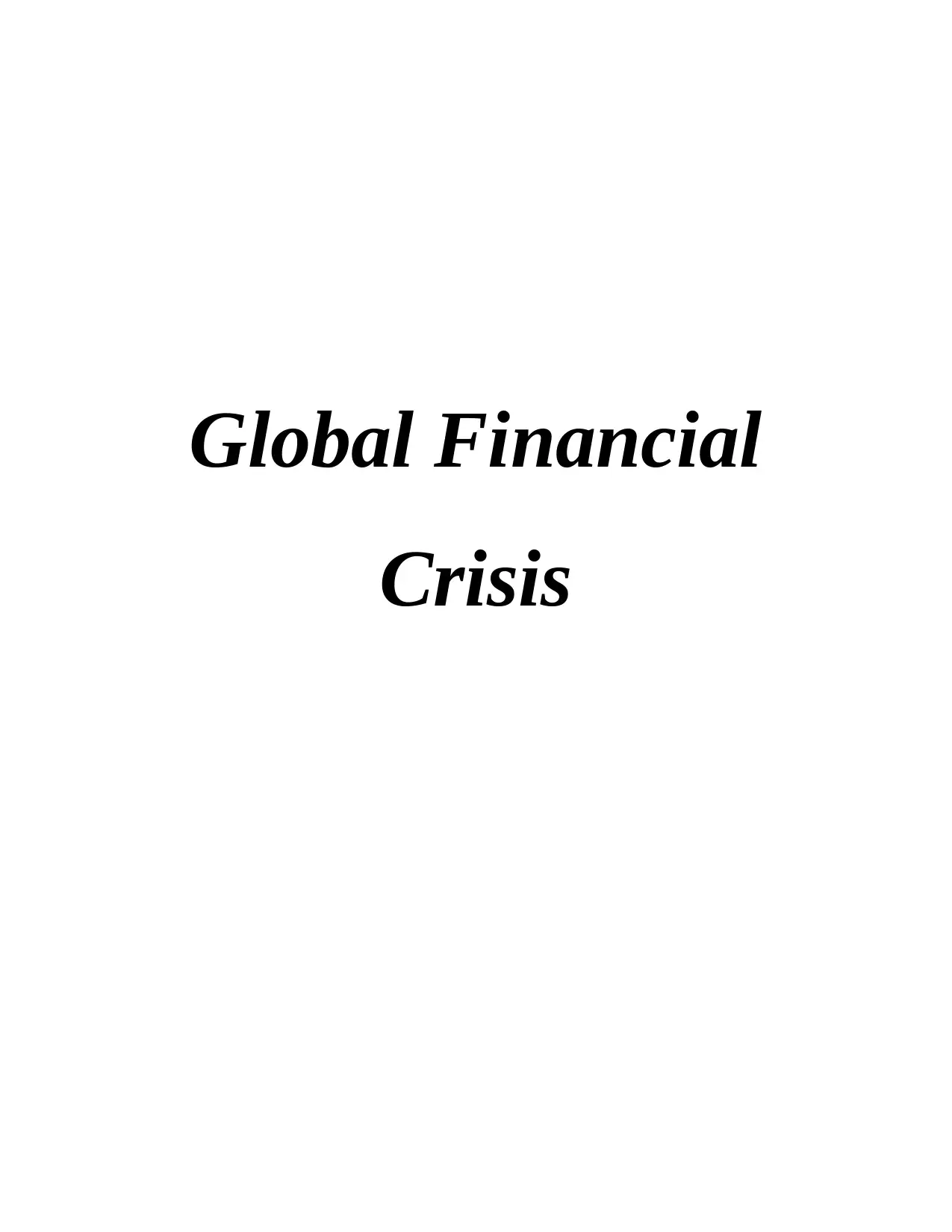
Global Financial
Crisis
Crisis
Paraphrase This Document
Need a fresh take? Get an instant paraphrase of this document with our AI Paraphraser
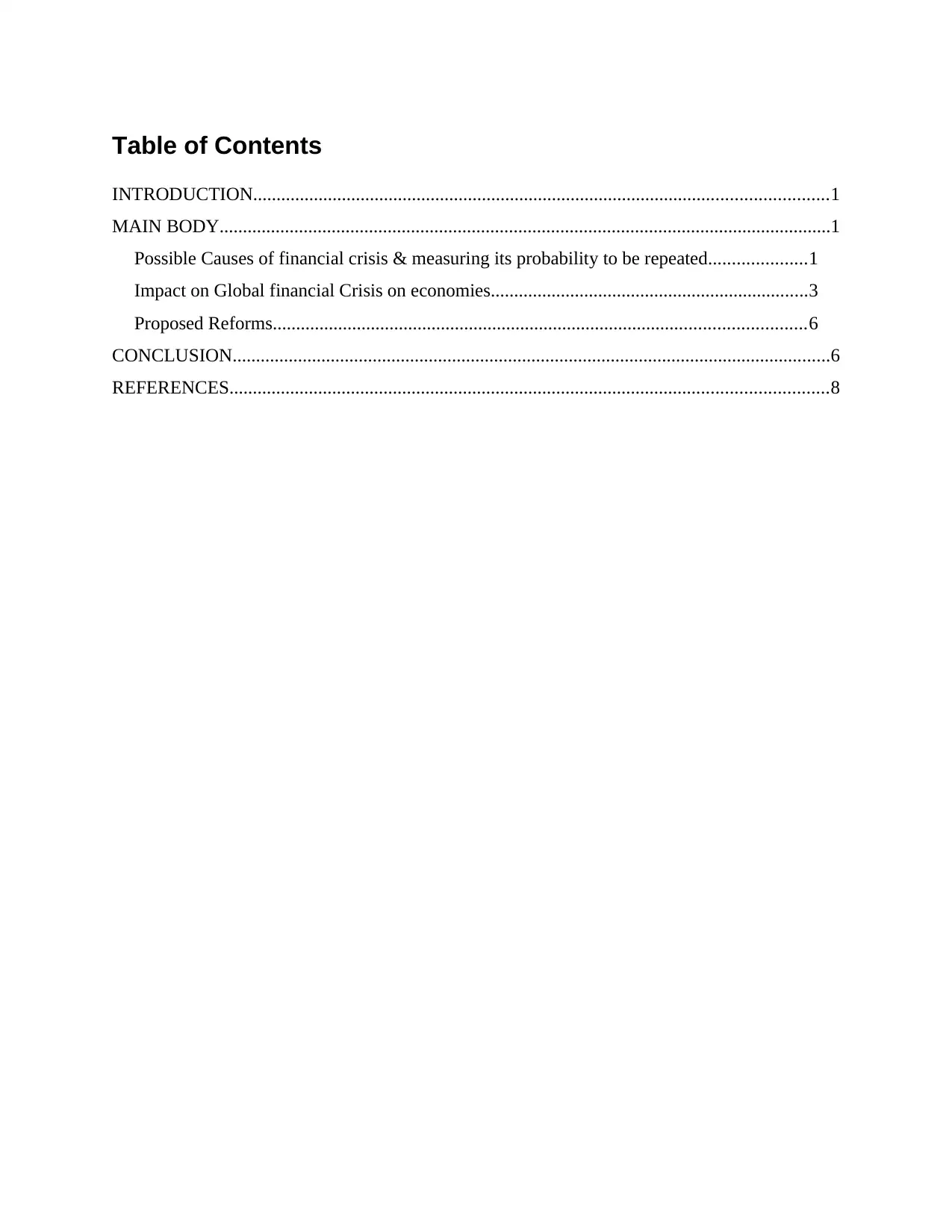
Table of Contents
INTRODUCTION...........................................................................................................................1
MAIN BODY...................................................................................................................................1
Possible Causes of financial crisis & measuring its probability to be repeated.....................1
Impact on Global financial Crisis on economies....................................................................3
Proposed Reforms..................................................................................................................6
CONCLUSION................................................................................................................................6
REFERENCES................................................................................................................................8
INTRODUCTION...........................................................................................................................1
MAIN BODY...................................................................................................................................1
Possible Causes of financial crisis & measuring its probability to be repeated.....................1
Impact on Global financial Crisis on economies....................................................................3
Proposed Reforms..................................................................................................................6
CONCLUSION................................................................................................................................6
REFERENCES................................................................................................................................8
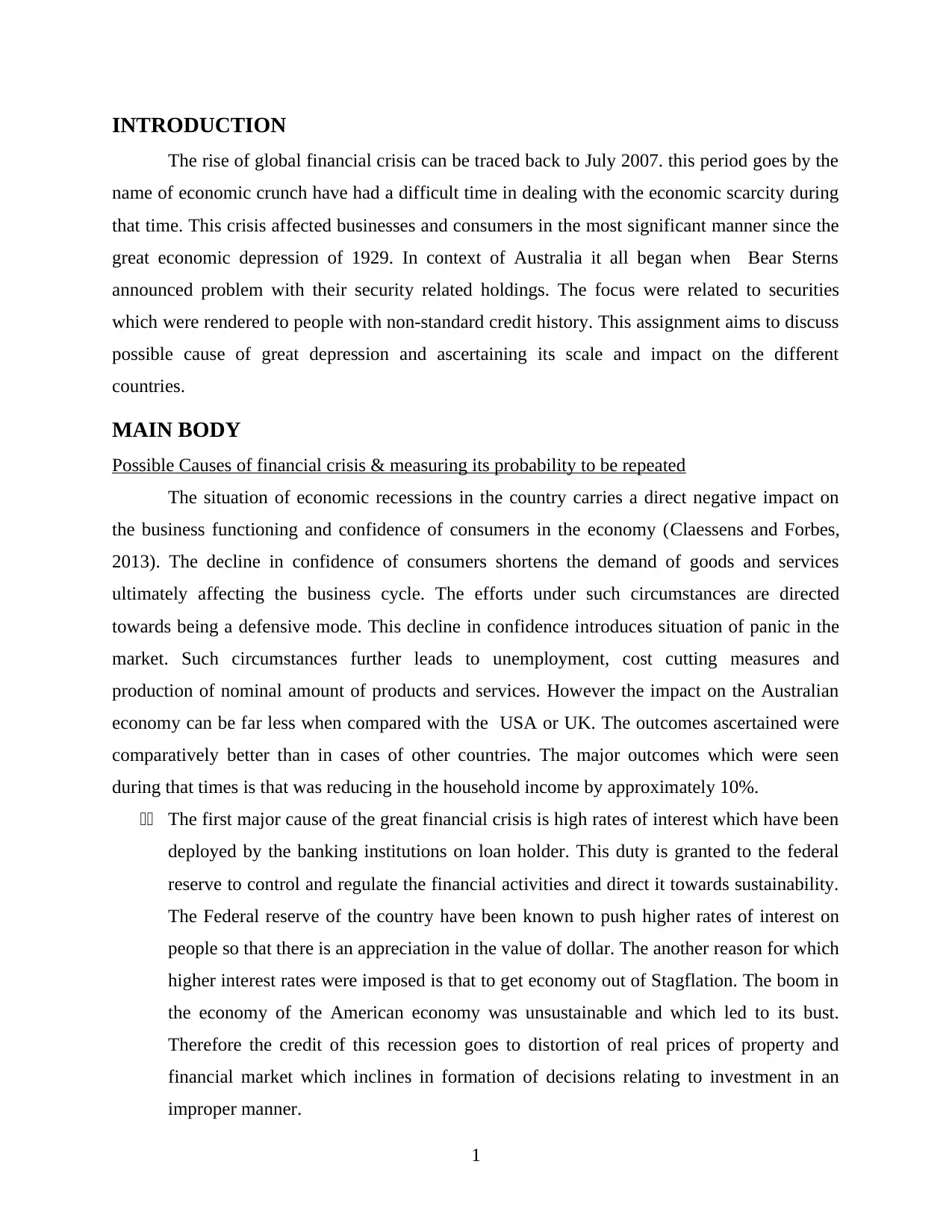
INTRODUCTION
The rise of global financial crisis can be traced back to July 2007. this period goes by the
name of economic crunch have had a difficult time in dealing with the economic scarcity during
that time. This crisis affected businesses and consumers in the most significant manner since the
great economic depression of 1929. In context of Australia it all began when Bear Sterns
announced problem with their security related holdings. The focus were related to securities
which were rendered to people with non-standard credit history. This assignment aims to discuss
possible cause of great depression and ascertaining its scale and impact on the different
countries.
MAIN BODY
Possible Causes of financial crisis & measuring its probability to be repeated
The situation of economic recessions in the country carries a direct negative impact on
the business functioning and confidence of consumers in the economy (Claessens and Forbes,
2013). The decline in confidence of consumers shortens the demand of goods and services
ultimately affecting the business cycle. The efforts under such circumstances are directed
towards being a defensive mode. This decline in confidence introduces situation of panic in the
market. Such circumstances further leads to unemployment, cost cutting measures and
production of nominal amount of products and services. However the impact on the Australian
economy can be far less when compared with the USA or UK. The outcomes ascertained were
comparatively better than in cases of other countries. The major outcomes which were seen
during that times is that was reducing in the household income by approximately 10%.
11 The first major cause of the great financial crisis is high rates of interest which have been
deployed by the banking institutions on loan holder. This duty is granted to the federal
reserve to control and regulate the financial activities and direct it towards sustainability.
The Federal reserve of the country have been known to push higher rates of interest on
people so that there is an appreciation in the value of dollar. The another reason for which
higher interest rates were imposed is that to get economy out of Stagflation. The boom in
the economy of the American economy was unsustainable and which led to its bust.
Therefore the credit of this recession goes to distortion of real prices of property and
financial market which inclines in formation of decisions relating to investment in an
improper manner.
1
The rise of global financial crisis can be traced back to July 2007. this period goes by the
name of economic crunch have had a difficult time in dealing with the economic scarcity during
that time. This crisis affected businesses and consumers in the most significant manner since the
great economic depression of 1929. In context of Australia it all began when Bear Sterns
announced problem with their security related holdings. The focus were related to securities
which were rendered to people with non-standard credit history. This assignment aims to discuss
possible cause of great depression and ascertaining its scale and impact on the different
countries.
MAIN BODY
Possible Causes of financial crisis & measuring its probability to be repeated
The situation of economic recessions in the country carries a direct negative impact on
the business functioning and confidence of consumers in the economy (Claessens and Forbes,
2013). The decline in confidence of consumers shortens the demand of goods and services
ultimately affecting the business cycle. The efforts under such circumstances are directed
towards being a defensive mode. This decline in confidence introduces situation of panic in the
market. Such circumstances further leads to unemployment, cost cutting measures and
production of nominal amount of products and services. However the impact on the Australian
economy can be far less when compared with the USA or UK. The outcomes ascertained were
comparatively better than in cases of other countries. The major outcomes which were seen
during that times is that was reducing in the household income by approximately 10%.
11 The first major cause of the great financial crisis is high rates of interest which have been
deployed by the banking institutions on loan holder. This duty is granted to the federal
reserve to control and regulate the financial activities and direct it towards sustainability.
The Federal reserve of the country have been known to push higher rates of interest on
people so that there is an appreciation in the value of dollar. The another reason for which
higher interest rates were imposed is that to get economy out of Stagflation. The boom in
the economy of the American economy was unsustainable and which led to its bust.
Therefore the credit of this recession goes to distortion of real prices of property and
financial market which inclines in formation of decisions relating to investment in an
improper manner.
1
⊘ This is a preview!⊘
Do you want full access?
Subscribe today to unlock all pages.

Trusted by 1+ million students worldwide
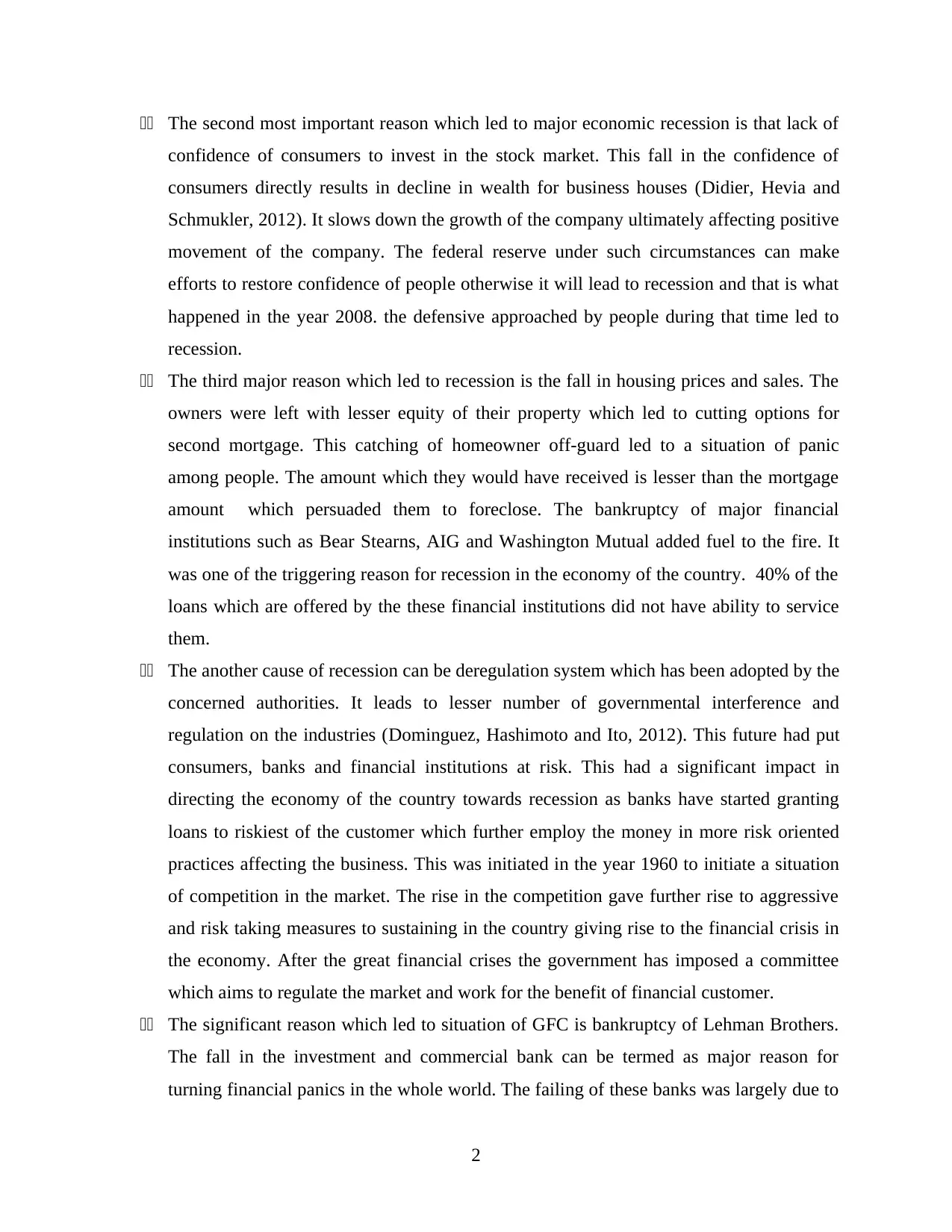
11 The second most important reason which led to major economic recession is that lack of
confidence of consumers to invest in the stock market. This fall in the confidence of
consumers directly results in decline in wealth for business houses (Didier, Hevia and
Schmukler, 2012). It slows down the growth of the company ultimately affecting positive
movement of the company. The federal reserve under such circumstances can make
efforts to restore confidence of people otherwise it will lead to recession and that is what
happened in the year 2008. the defensive approached by people during that time led to
recession.
11 The third major reason which led to recession is the fall in housing prices and sales. The
owners were left with lesser equity of their property which led to cutting options for
second mortgage. This catching of homeowner off-guard led to a situation of panic
among people. The amount which they would have received is lesser than the mortgage
amount which persuaded them to foreclose. The bankruptcy of major financial
institutions such as Bear Stearns, AIG and Washington Mutual added fuel to the fire. It
was one of the triggering reason for recession in the economy of the country. 40% of the
loans which are offered by the these financial institutions did not have ability to service
them.
11 The another cause of recession can be deregulation system which has been adopted by the
concerned authorities. It leads to lesser number of governmental interference and
regulation on the industries (Dominguez, Hashimoto and Ito, 2012). This future had put
consumers, banks and financial institutions at risk. This had a significant impact in
directing the economy of the country towards recession as banks have started granting
loans to riskiest of the customer which further employ the money in more risk oriented
practices affecting the business. This was initiated in the year 1960 to initiate a situation
of competition in the market. The rise in the competition gave further rise to aggressive
and risk taking measures to sustaining in the country giving rise to the financial crisis in
the economy. After the great financial crises the government has imposed a committee
which aims to regulate the market and work for the benefit of financial customer.
11 The significant reason which led to situation of GFC is bankruptcy of Lehman Brothers.
The fall in the investment and commercial bank can be termed as major reason for
turning financial panics in the whole world. The failing of these banks was largely due to
2
confidence of consumers to invest in the stock market. This fall in the confidence of
consumers directly results in decline in wealth for business houses (Didier, Hevia and
Schmukler, 2012). It slows down the growth of the company ultimately affecting positive
movement of the company. The federal reserve under such circumstances can make
efforts to restore confidence of people otherwise it will lead to recession and that is what
happened in the year 2008. the defensive approached by people during that time led to
recession.
11 The third major reason which led to recession is the fall in housing prices and sales. The
owners were left with lesser equity of their property which led to cutting options for
second mortgage. This catching of homeowner off-guard led to a situation of panic
among people. The amount which they would have received is lesser than the mortgage
amount which persuaded them to foreclose. The bankruptcy of major financial
institutions such as Bear Stearns, AIG and Washington Mutual added fuel to the fire. It
was one of the triggering reason for recession in the economy of the country. 40% of the
loans which are offered by the these financial institutions did not have ability to service
them.
11 The another cause of recession can be deregulation system which has been adopted by the
concerned authorities. It leads to lesser number of governmental interference and
regulation on the industries (Dominguez, Hashimoto and Ito, 2012). This future had put
consumers, banks and financial institutions at risk. This had a significant impact in
directing the economy of the country towards recession as banks have started granting
loans to riskiest of the customer which further employ the money in more risk oriented
practices affecting the business. This was initiated in the year 1960 to initiate a situation
of competition in the market. The rise in the competition gave further rise to aggressive
and risk taking measures to sustaining in the country giving rise to the financial crisis in
the economy. After the great financial crises the government has imposed a committee
which aims to regulate the market and work for the benefit of financial customer.
11 The significant reason which led to situation of GFC is bankruptcy of Lehman Brothers.
The fall in the investment and commercial bank can be termed as major reason for
turning financial panics in the whole world. The failing of these banks was largely due to
2
Paraphrase This Document
Need a fresh take? Get an instant paraphrase of this document with our AI Paraphraser
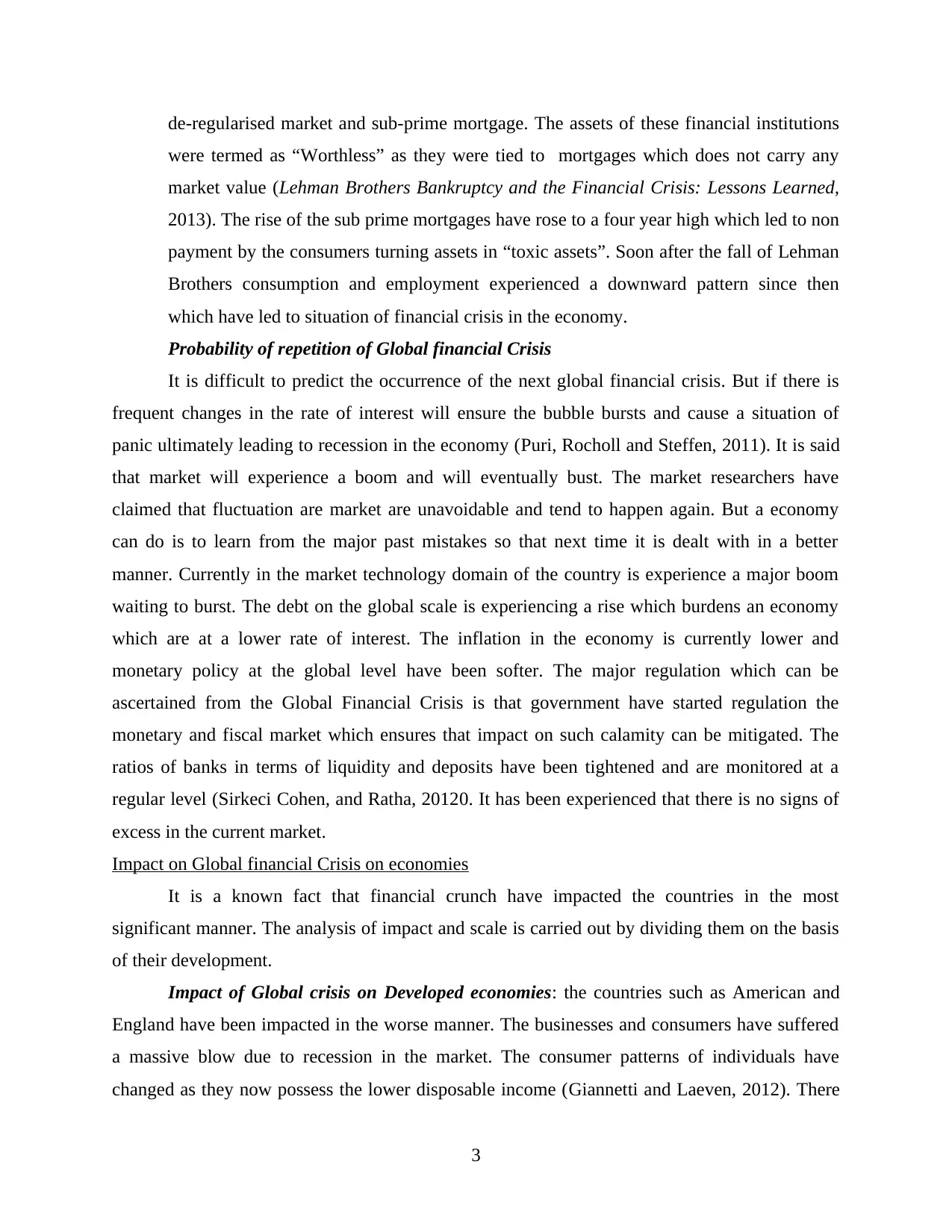
de-regularised market and sub-prime mortgage. The assets of these financial institutions
were termed as “Worthless” as they were tied to mortgages which does not carry any
market value (Lehman Brothers Bankruptcy and the Financial Crisis: Lessons Learned,
2013). The rise of the sub prime mortgages have rose to a four year high which led to non
payment by the consumers turning assets in “toxic assets”. Soon after the fall of Lehman
Brothers consumption and employment experienced a downward pattern since then
which have led to situation of financial crisis in the economy.
Probability of repetition of Global financial Crisis
It is difficult to predict the occurrence of the next global financial crisis. But if there is
frequent changes in the rate of interest will ensure the bubble bursts and cause a situation of
panic ultimately leading to recession in the economy (Puri, Rocholl and Steffen, 2011). It is said
that market will experience a boom and will eventually bust. The market researchers have
claimed that fluctuation are market are unavoidable and tend to happen again. But a economy
can do is to learn from the major past mistakes so that next time it is dealt with in a better
manner. Currently in the market technology domain of the country is experience a major boom
waiting to burst. The debt on the global scale is experiencing a rise which burdens an economy
which are at a lower rate of interest. The inflation in the economy is currently lower and
monetary policy at the global level have been softer. The major regulation which can be
ascertained from the Global Financial Crisis is that government have started regulation the
monetary and fiscal market which ensures that impact on such calamity can be mitigated. The
ratios of banks in terms of liquidity and deposits have been tightened and are monitored at a
regular level (Sirkeci Cohen, and Ratha, 20120. It has been experienced that there is no signs of
excess in the current market.
Impact on Global financial Crisis on economies
It is a known fact that financial crunch have impacted the countries in the most
significant manner. The analysis of impact and scale is carried out by dividing them on the basis
of their development.
Impact of Global crisis on Developed economies: the countries such as American and
England have been impacted in the worse manner. The businesses and consumers have suffered
a massive blow due to recession in the market. The consumer patterns of individuals have
changed as they now possess the lower disposable income (Giannetti and Laeven, 2012). There
3
were termed as “Worthless” as they were tied to mortgages which does not carry any
market value (Lehman Brothers Bankruptcy and the Financial Crisis: Lessons Learned,
2013). The rise of the sub prime mortgages have rose to a four year high which led to non
payment by the consumers turning assets in “toxic assets”. Soon after the fall of Lehman
Brothers consumption and employment experienced a downward pattern since then
which have led to situation of financial crisis in the economy.
Probability of repetition of Global financial Crisis
It is difficult to predict the occurrence of the next global financial crisis. But if there is
frequent changes in the rate of interest will ensure the bubble bursts and cause a situation of
panic ultimately leading to recession in the economy (Puri, Rocholl and Steffen, 2011). It is said
that market will experience a boom and will eventually bust. The market researchers have
claimed that fluctuation are market are unavoidable and tend to happen again. But a economy
can do is to learn from the major past mistakes so that next time it is dealt with in a better
manner. Currently in the market technology domain of the country is experience a major boom
waiting to burst. The debt on the global scale is experiencing a rise which burdens an economy
which are at a lower rate of interest. The inflation in the economy is currently lower and
monetary policy at the global level have been softer. The major regulation which can be
ascertained from the Global Financial Crisis is that government have started regulation the
monetary and fiscal market which ensures that impact on such calamity can be mitigated. The
ratios of banks in terms of liquidity and deposits have been tightened and are monitored at a
regular level (Sirkeci Cohen, and Ratha, 20120. It has been experienced that there is no signs of
excess in the current market.
Impact on Global financial Crisis on economies
It is a known fact that financial crunch have impacted the countries in the most
significant manner. The analysis of impact and scale is carried out by dividing them on the basis
of their development.
Impact of Global crisis on Developed economies: the countries such as American and
England have been impacted in the worse manner. The businesses and consumers have suffered
a massive blow due to recession in the market. The consumer patterns of individuals have
changed as they now possess the lower disposable income (Giannetti and Laeven, 2012). There
3
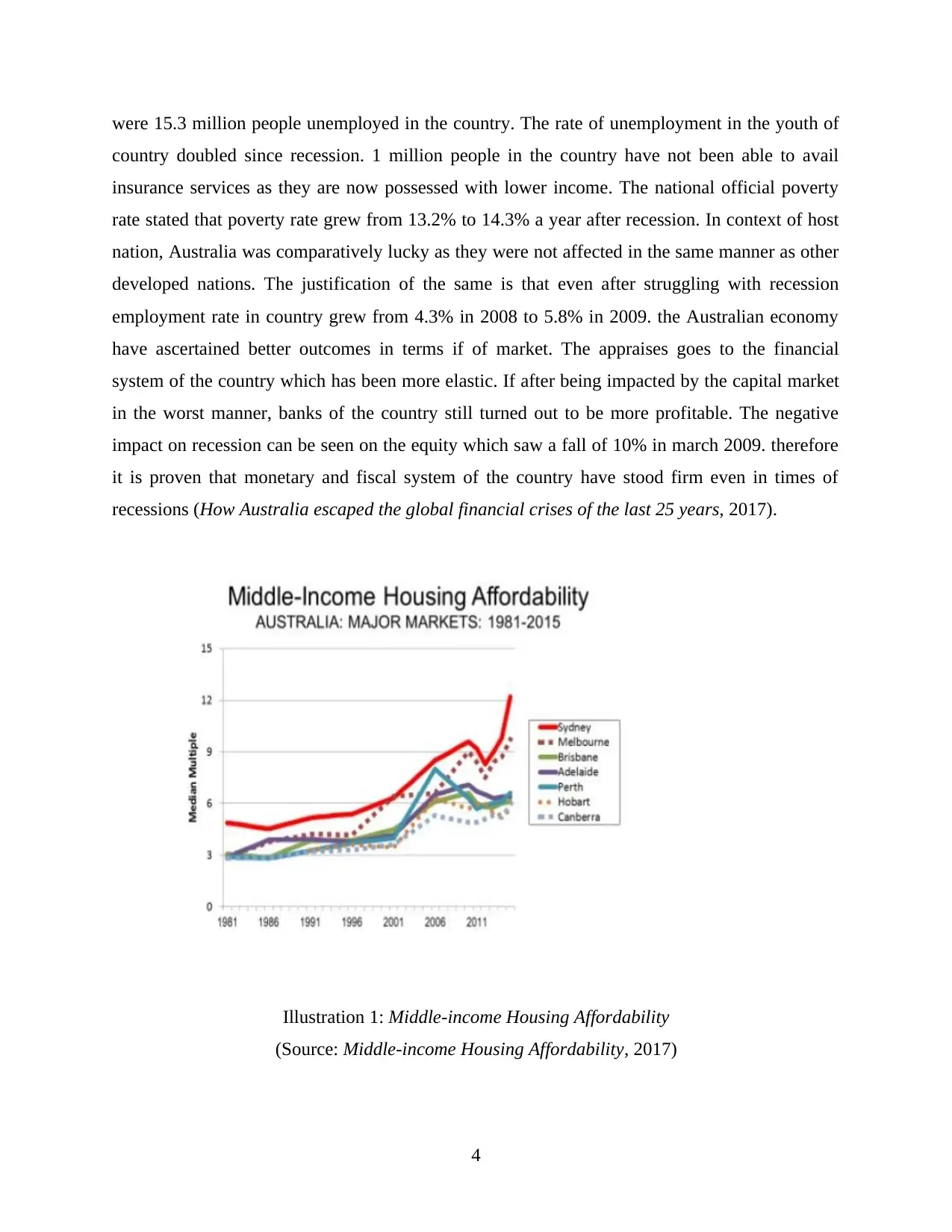
were 15.3 million people unemployed in the country. The rate of unemployment in the youth of
country doubled since recession. 1 million people in the country have not been able to avail
insurance services as they are now possessed with lower income. The national official poverty
rate stated that poverty rate grew from 13.2% to 14.3% a year after recession. In context of host
nation, Australia was comparatively lucky as they were not affected in the same manner as other
developed nations. The justification of the same is that even after struggling with recession
employment rate in country grew from 4.3% in 2008 to 5.8% in 2009. the Australian economy
have ascertained better outcomes in terms if of market. The appraises goes to the financial
system of the country which has been more elastic. If after being impacted by the capital market
in the worst manner, banks of the country still turned out to be more profitable. The negative
impact on recession can be seen on the equity which saw a fall of 10% in march 2009. therefore
it is proven that monetary and fiscal system of the country have stood firm even in times of
recessions (How Australia escaped the global financial crises of the last 25 years, 2017).
(Source: Middle-income Housing Affordability, 2017)
4
Illustration 1: Middle-income Housing Affordability
country doubled since recession. 1 million people in the country have not been able to avail
insurance services as they are now possessed with lower income. The national official poverty
rate stated that poverty rate grew from 13.2% to 14.3% a year after recession. In context of host
nation, Australia was comparatively lucky as they were not affected in the same manner as other
developed nations. The justification of the same is that even after struggling with recession
employment rate in country grew from 4.3% in 2008 to 5.8% in 2009. the Australian economy
have ascertained better outcomes in terms if of market. The appraises goes to the financial
system of the country which has been more elastic. If after being impacted by the capital market
in the worst manner, banks of the country still turned out to be more profitable. The negative
impact on recession can be seen on the equity which saw a fall of 10% in march 2009. therefore
it is proven that monetary and fiscal system of the country have stood firm even in times of
recessions (How Australia escaped the global financial crises of the last 25 years, 2017).
(Source: Middle-income Housing Affordability, 2017)
4
Illustration 1: Middle-income Housing Affordability
⊘ This is a preview!⊘
Do you want full access?
Subscribe today to unlock all pages.

Trusted by 1+ million students worldwide
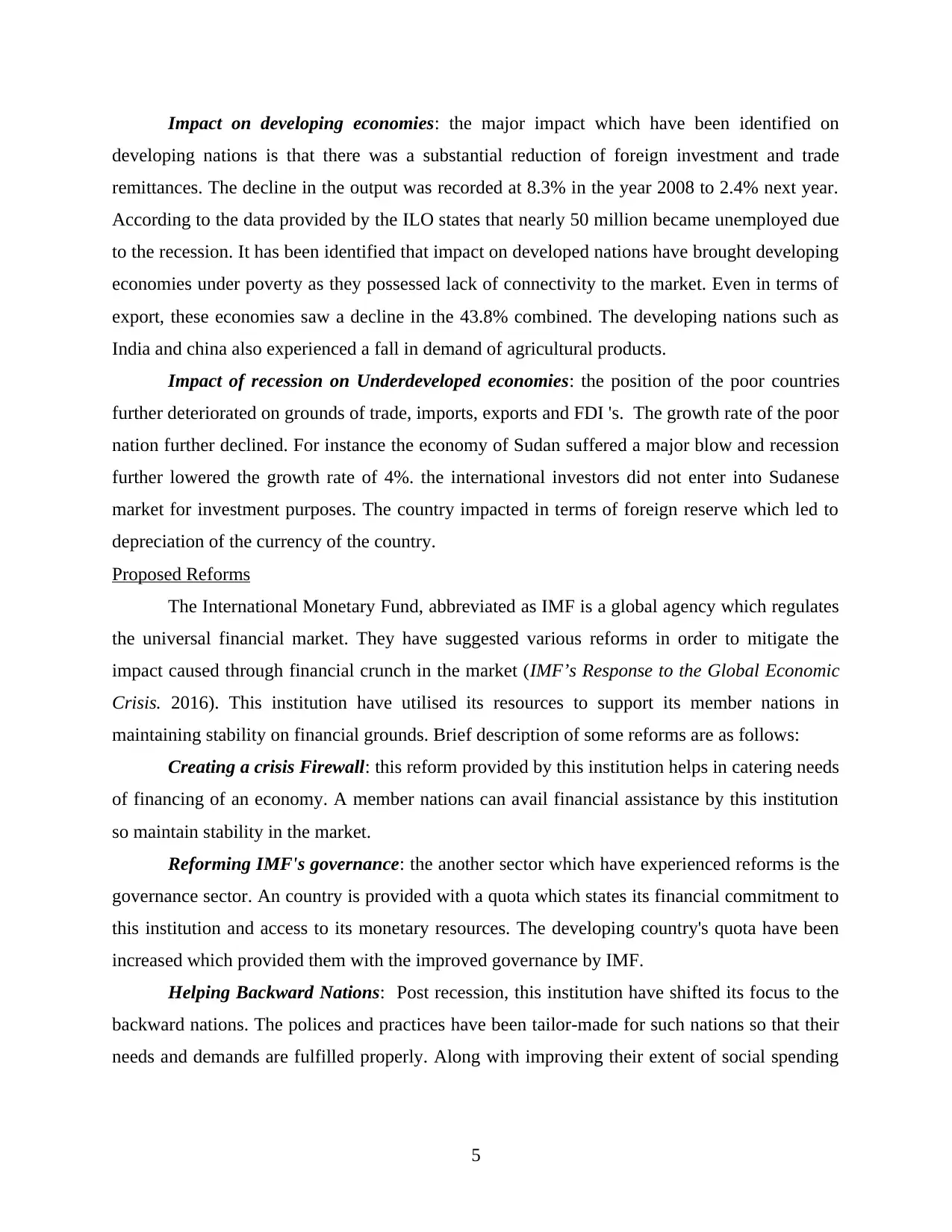
Impact on developing economies: the major impact which have been identified on
developing nations is that there was a substantial reduction of foreign investment and trade
remittances. The decline in the output was recorded at 8.3% in the year 2008 to 2.4% next year.
According to the data provided by the ILO states that nearly 50 million became unemployed due
to the recession. It has been identified that impact on developed nations have brought developing
economies under poverty as they possessed lack of connectivity to the market. Even in terms of
export, these economies saw a decline in the 43.8% combined. The developing nations such as
India and china also experienced a fall in demand of agricultural products.
Impact of recession on Underdeveloped economies: the position of the poor countries
further deteriorated on grounds of trade, imports, exports and FDI 's. The growth rate of the poor
nation further declined. For instance the economy of Sudan suffered a major blow and recession
further lowered the growth rate of 4%. the international investors did not enter into Sudanese
market for investment purposes. The country impacted in terms of foreign reserve which led to
depreciation of the currency of the country.
Proposed Reforms
The International Monetary Fund, abbreviated as IMF is a global agency which regulates
the universal financial market. They have suggested various reforms in order to mitigate the
impact caused through financial crunch in the market (IMF’s Response to the Global Economic
Crisis. 2016). This institution have utilised its resources to support its member nations in
maintaining stability on financial grounds. Brief description of some reforms are as follows:
Creating a crisis Firewall: this reform provided by this institution helps in catering needs
of financing of an economy. A member nations can avail financial assistance by this institution
so maintain stability in the market.
Reforming IMF's governance: the another sector which have experienced reforms is the
governance sector. An country is provided with a quota which states its financial commitment to
this institution and access to its monetary resources. The developing country's quota have been
increased which provided them with the improved governance by IMF.
Helping Backward Nations: Post recession, this institution have shifted its focus to the
backward nations. The polices and practices have been tailor-made for such nations so that their
needs and demands are fulfilled properly. Along with improving their extent of social spending
5
developing nations is that there was a substantial reduction of foreign investment and trade
remittances. The decline in the output was recorded at 8.3% in the year 2008 to 2.4% next year.
According to the data provided by the ILO states that nearly 50 million became unemployed due
to the recession. It has been identified that impact on developed nations have brought developing
economies under poverty as they possessed lack of connectivity to the market. Even in terms of
export, these economies saw a decline in the 43.8% combined. The developing nations such as
India and china also experienced a fall in demand of agricultural products.
Impact of recession on Underdeveloped economies: the position of the poor countries
further deteriorated on grounds of trade, imports, exports and FDI 's. The growth rate of the poor
nation further declined. For instance the economy of Sudan suffered a major blow and recession
further lowered the growth rate of 4%. the international investors did not enter into Sudanese
market for investment purposes. The country impacted in terms of foreign reserve which led to
depreciation of the currency of the country.
Proposed Reforms
The International Monetary Fund, abbreviated as IMF is a global agency which regulates
the universal financial market. They have suggested various reforms in order to mitigate the
impact caused through financial crunch in the market (IMF’s Response to the Global Economic
Crisis. 2016). This institution have utilised its resources to support its member nations in
maintaining stability on financial grounds. Brief description of some reforms are as follows:
Creating a crisis Firewall: this reform provided by this institution helps in catering needs
of financing of an economy. A member nations can avail financial assistance by this institution
so maintain stability in the market.
Reforming IMF's governance: the another sector which have experienced reforms is the
governance sector. An country is provided with a quota which states its financial commitment to
this institution and access to its monetary resources. The developing country's quota have been
increased which provided them with the improved governance by IMF.
Helping Backward Nations: Post recession, this institution have shifted its focus to the
backward nations. The polices and practices have been tailor-made for such nations so that their
needs and demands are fulfilled properly. Along with improving their extent of social spending
5
Paraphrase This Document
Need a fresh take? Get an instant paraphrase of this document with our AI Paraphraser
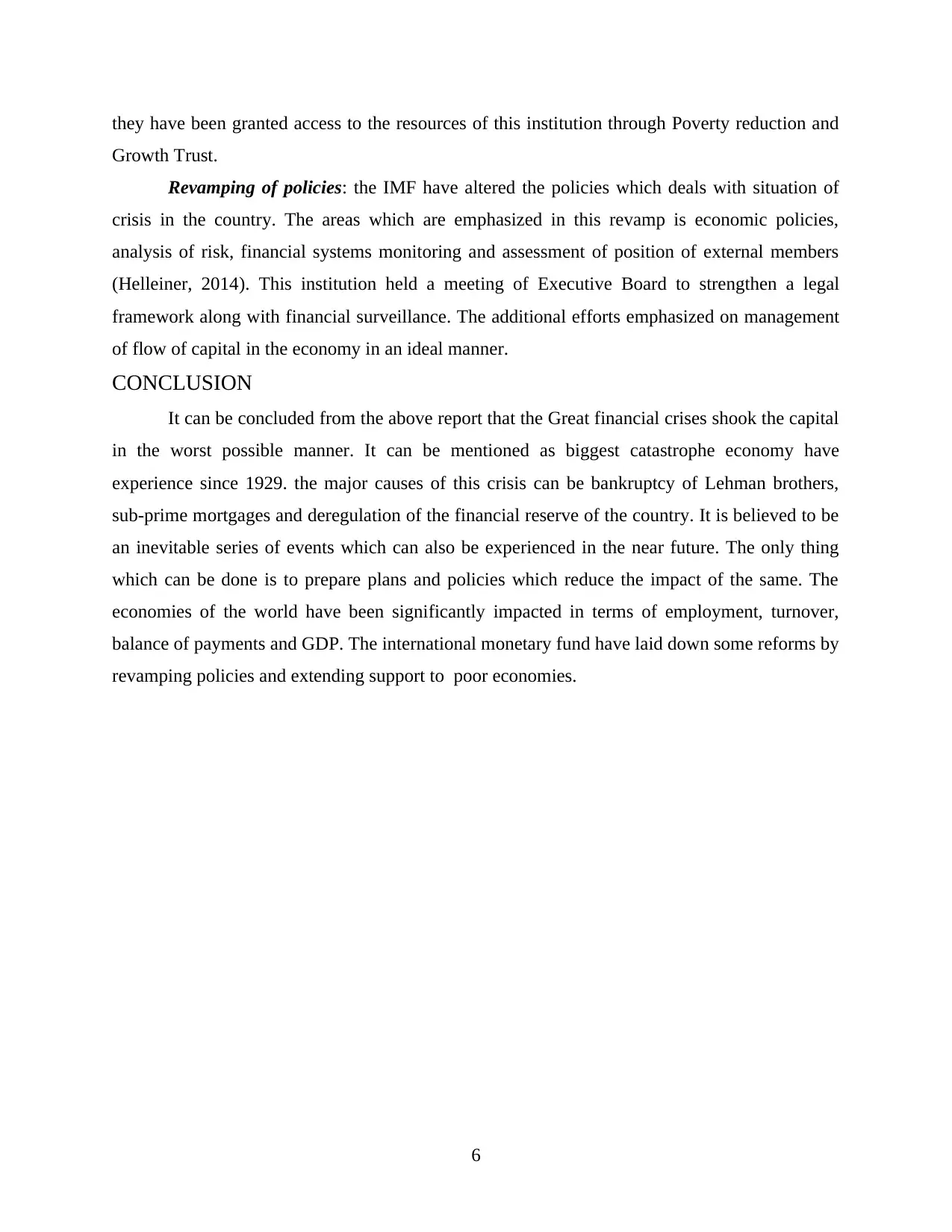
they have been granted access to the resources of this institution through Poverty reduction and
Growth Trust.
Revamping of policies: the IMF have altered the policies which deals with situation of
crisis in the country. The areas which are emphasized in this revamp is economic policies,
analysis of risk, financial systems monitoring and assessment of position of external members
(Helleiner, 2014). This institution held a meeting of Executive Board to strengthen a legal
framework along with financial surveillance. The additional efforts emphasized on management
of flow of capital in the economy in an ideal manner.
CONCLUSION
It can be concluded from the above report that the Great financial crises shook the capital
in the worst possible manner. It can be mentioned as biggest catastrophe economy have
experience since 1929. the major causes of this crisis can be bankruptcy of Lehman brothers,
sub-prime mortgages and deregulation of the financial reserve of the country. It is believed to be
an inevitable series of events which can also be experienced in the near future. The only thing
which can be done is to prepare plans and policies which reduce the impact of the same. The
economies of the world have been significantly impacted in terms of employment, turnover,
balance of payments and GDP. The international monetary fund have laid down some reforms by
revamping policies and extending support to poor economies.
6
Growth Trust.
Revamping of policies: the IMF have altered the policies which deals with situation of
crisis in the country. The areas which are emphasized in this revamp is economic policies,
analysis of risk, financial systems monitoring and assessment of position of external members
(Helleiner, 2014). This institution held a meeting of Executive Board to strengthen a legal
framework along with financial surveillance. The additional efforts emphasized on management
of flow of capital in the economy in an ideal manner.
CONCLUSION
It can be concluded from the above report that the Great financial crises shook the capital
in the worst possible manner. It can be mentioned as biggest catastrophe economy have
experience since 1929. the major causes of this crisis can be bankruptcy of Lehman brothers,
sub-prime mortgages and deregulation of the financial reserve of the country. It is believed to be
an inevitable series of events which can also be experienced in the near future. The only thing
which can be done is to prepare plans and policies which reduce the impact of the same. The
economies of the world have been significantly impacted in terms of employment, turnover,
balance of payments and GDP. The international monetary fund have laid down some reforms by
revamping policies and extending support to poor economies.
6
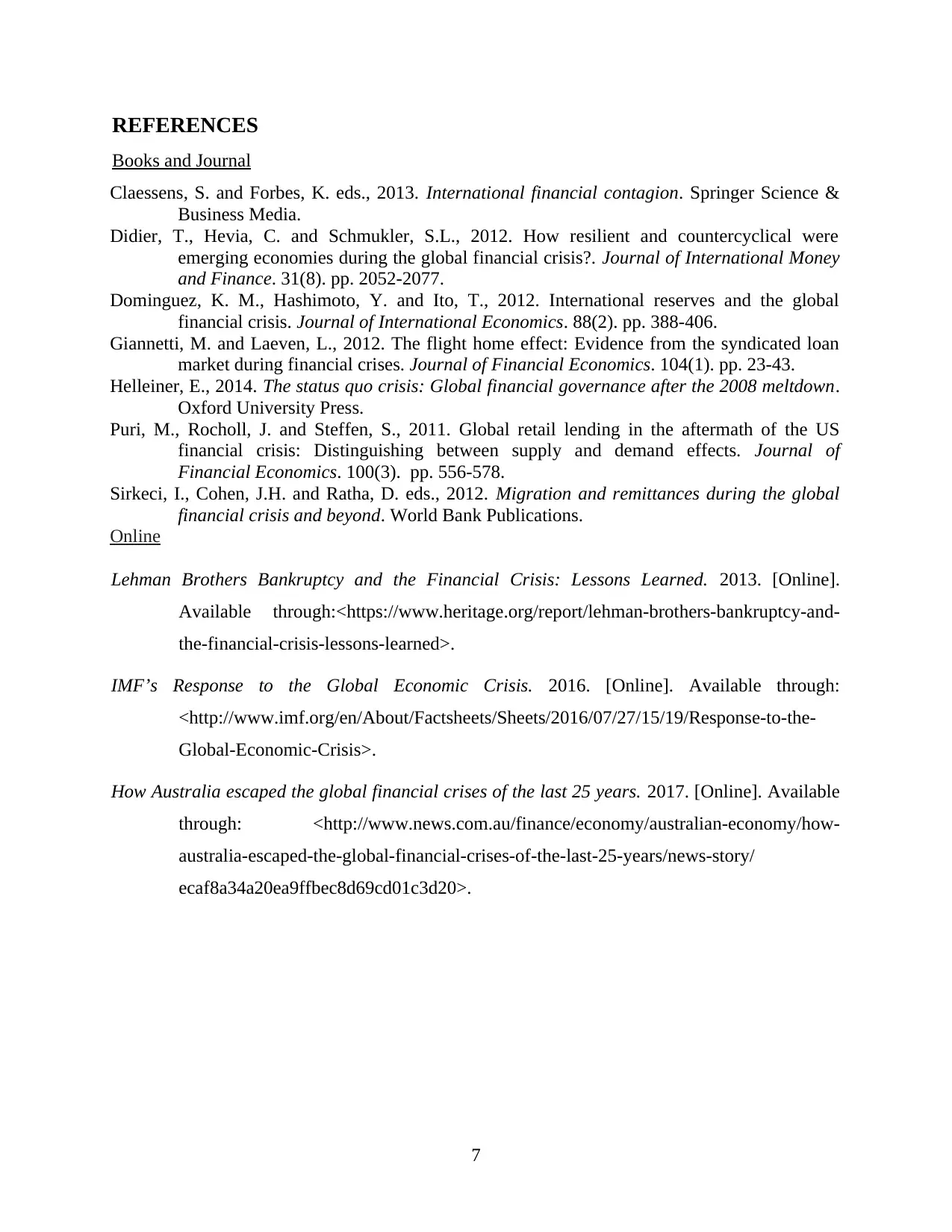
REFERENCES
Books and Journal
Claessens, S. and Forbes, K. eds., 2013. International financial contagion. Springer Science &
Business Media.
Didier, T., Hevia, C. and Schmukler, S.L., 2012. How resilient and countercyclical were
emerging economies during the global financial crisis?. Journal of International Money
and Finance. 31(8). pp. 2052-2077.
Dominguez, K. M., Hashimoto, Y. and Ito, T., 2012. International reserves and the global
financial crisis. Journal of International Economics. 88(2). pp. 388-406.
Giannetti, M. and Laeven, L., 2012. The flight home effect: Evidence from the syndicated loan
market during financial crises. Journal of Financial Economics. 104(1). pp. 23-43.
Helleiner, E., 2014. The status quo crisis: Global financial governance after the 2008 meltdown.
Oxford University Press.
Puri, M., Rocholl, J. and Steffen, S., 2011. Global retail lending in the aftermath of the US
financial crisis: Distinguishing between supply and demand effects. Journal of
Financial Economics. 100(3). pp. 556-578.
Sirkeci, I., Cohen, J.H. and Ratha, D. eds., 2012. Migration and remittances during the global
financial crisis and beyond. World Bank Publications.
Online
Lehman Brothers Bankruptcy and the Financial Crisis: Lessons Learned. 2013. [Online].
Available through:<https://www.heritage.org/report/lehman-brothers-bankruptcy-and-
the-financial-crisis-lessons-learned>.
IMF’s Response to the Global Economic Crisis. 2016. [Online]. Available through:
<http://www.imf.org/en/About/Factsheets/Sheets/2016/07/27/15/19/Response-to-the-
Global-Economic-Crisis>.
How Australia escaped the global financial crises of the last 25 years. 2017. [Online]. Available
through: <http://www.news.com.au/finance/economy/australian-economy/how-
australia-escaped-the-global-financial-crises-of-the-last-25-years/news-story/
ecaf8a34a20ea9ffbec8d69cd01c3d20>.
7
Books and Journal
Claessens, S. and Forbes, K. eds., 2013. International financial contagion. Springer Science &
Business Media.
Didier, T., Hevia, C. and Schmukler, S.L., 2012. How resilient and countercyclical were
emerging economies during the global financial crisis?. Journal of International Money
and Finance. 31(8). pp. 2052-2077.
Dominguez, K. M., Hashimoto, Y. and Ito, T., 2012. International reserves and the global
financial crisis. Journal of International Economics. 88(2). pp. 388-406.
Giannetti, M. and Laeven, L., 2012. The flight home effect: Evidence from the syndicated loan
market during financial crises. Journal of Financial Economics. 104(1). pp. 23-43.
Helleiner, E., 2014. The status quo crisis: Global financial governance after the 2008 meltdown.
Oxford University Press.
Puri, M., Rocholl, J. and Steffen, S., 2011. Global retail lending in the aftermath of the US
financial crisis: Distinguishing between supply and demand effects. Journal of
Financial Economics. 100(3). pp. 556-578.
Sirkeci, I., Cohen, J.H. and Ratha, D. eds., 2012. Migration and remittances during the global
financial crisis and beyond. World Bank Publications.
Online
Lehman Brothers Bankruptcy and the Financial Crisis: Lessons Learned. 2013. [Online].
Available through:<https://www.heritage.org/report/lehman-brothers-bankruptcy-and-
the-financial-crisis-lessons-learned>.
IMF’s Response to the Global Economic Crisis. 2016. [Online]. Available through:
<http://www.imf.org/en/About/Factsheets/Sheets/2016/07/27/15/19/Response-to-the-
Global-Economic-Crisis>.
How Australia escaped the global financial crises of the last 25 years. 2017. [Online]. Available
through: <http://www.news.com.au/finance/economy/australian-economy/how-
australia-escaped-the-global-financial-crises-of-the-last-25-years/news-story/
ecaf8a34a20ea9ffbec8d69cd01c3d20>.
7
⊘ This is a preview!⊘
Do you want full access?
Subscribe today to unlock all pages.

Trusted by 1+ million students worldwide
1 out of 9
Related Documents
Your All-in-One AI-Powered Toolkit for Academic Success.
+13062052269
info@desklib.com
Available 24*7 on WhatsApp / Email
![[object Object]](/_next/static/media/star-bottom.7253800d.svg)
Unlock your academic potential
Copyright © 2020–2025 A2Z Services. All Rights Reserved. Developed and managed by ZUCOL.





